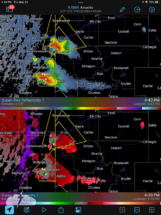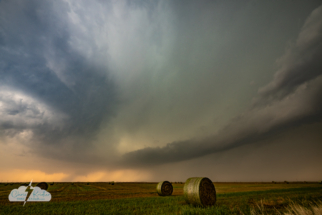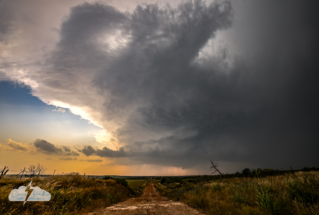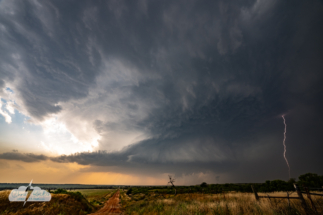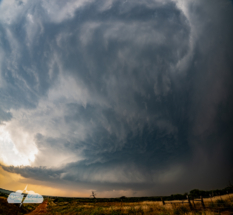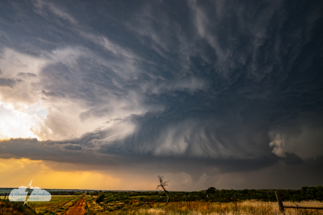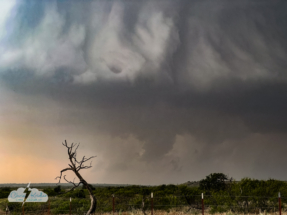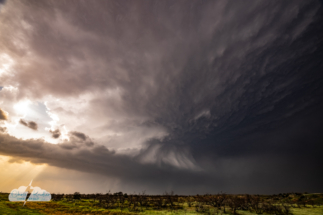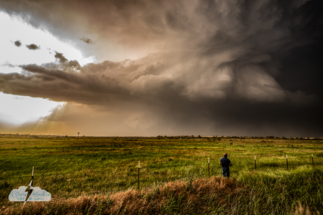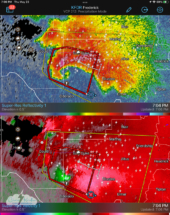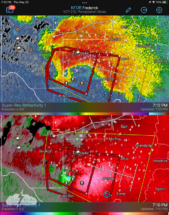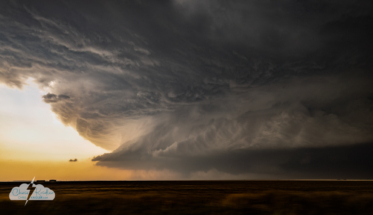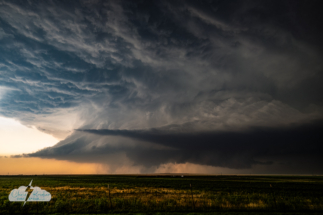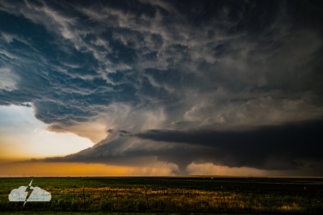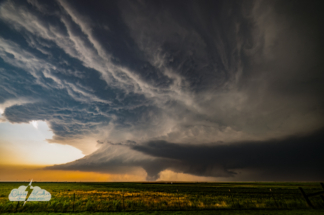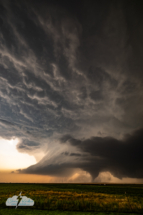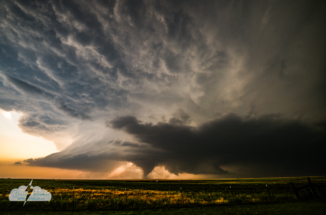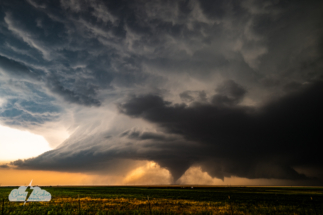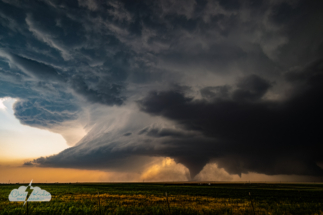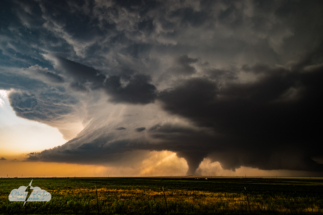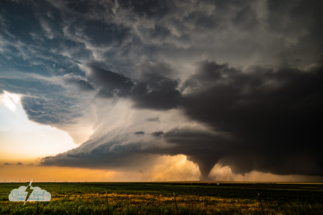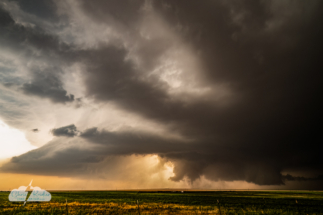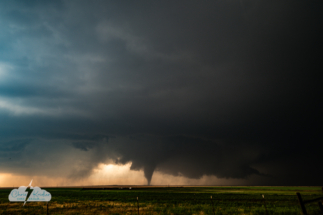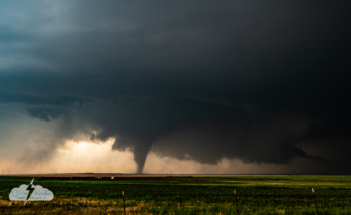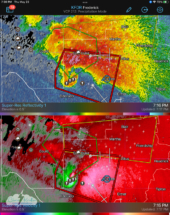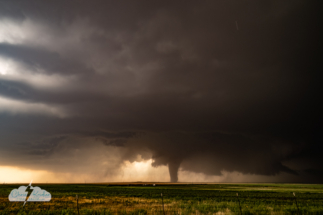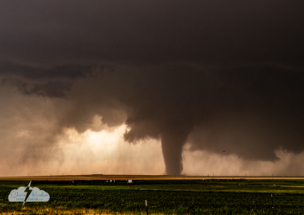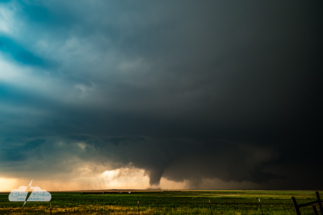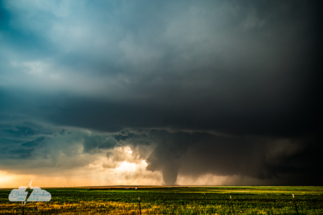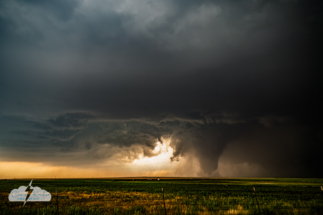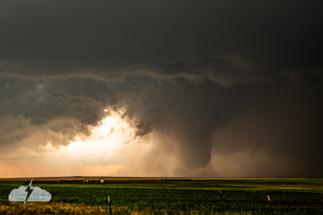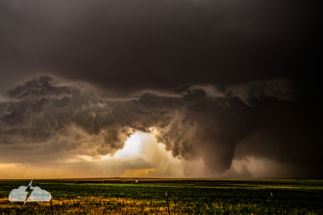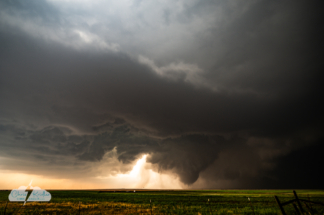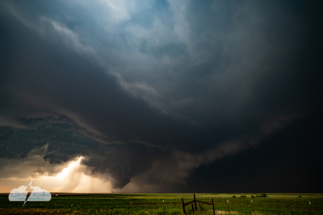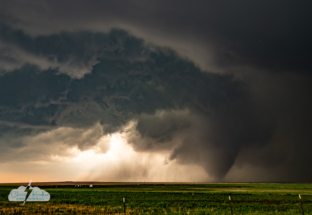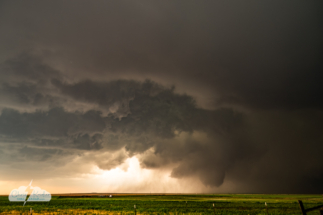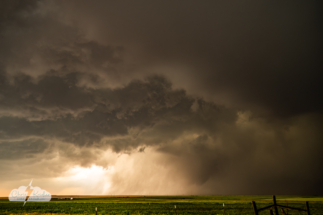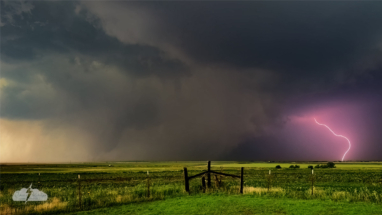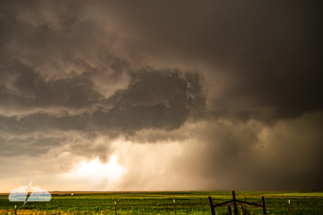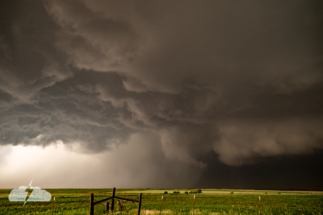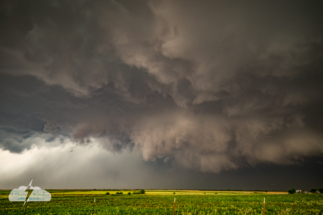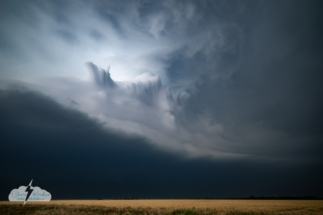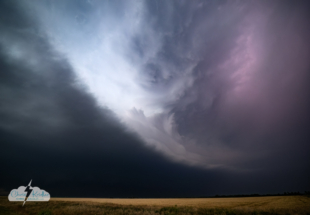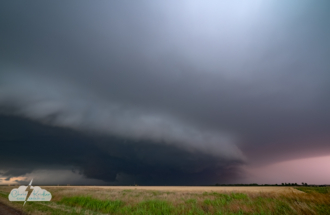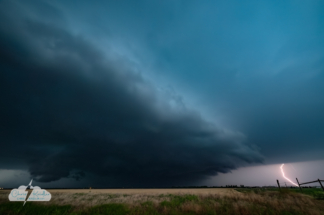Chris Kridler
Chris Kridler is a writer, photographer and storm chaser and author of the Storm Seekers Series of storm-chasing adventures.
Chris Kridler is a writer, photographer and storm chaser and author of the Storm Seekers Series of storm-chasing adventures.
I missed the “big night” – there’s always one night when many, many of the blooms explode – because I returned from chasing storms the day after. But the blooms do appear for a while, popping up here and there. Until they don’t.
I’ve made several of these videos that you can see on my YouTube channel (please subscribe!), including a mini documentary that will tell you a little more about the blooms. This year’s video focuses on the mesmerizing beauty of one of these flowers as it opens. Check it out.
We’re back from Tornado Alley! This trip with my storm-chasing partner Alethea Kontis went all too quickly, even though it was two and a half weeks. I sometimes wish I had the freedom to chase for a couple of months at a time, as some chasers do, but I still have a day job (editing books) and a fun job (writing books) and a husband and dogs and a life at home. So I enjoy the trip, and then I look for lightning when I get back home to Florida.
We saw five or six tornadoes, but most of them were in the “murknadoes” category — far away or difficult to see. The best tornado photo I got was probably a shot of a skinny little thing in Missouri, where I’d never seen a tornado before. And why “or six”? The last one was so murky, it’s super hard to see in my video, even though I think it’s there. All of this is to illustrate why seeing tornadoes is not really the most important thing to me when I chase storms, though I’m still frustrated when I miss them. Especially because our chase crew missed a couple of really photogenic tornadic storms due to bad decisions or poor timing. That’s the way the weather works sometimes and the way chasing works as well. Regardless, we still found beautiful storms to photograph.
One of the best things about this season — my 29th — was getting together with good friends whom we’ve barely seen in the past few years. Chasing together was a huge amount of fun. We hit thirteen states and drove more than 9500 miles, so we packed in a lot of adventure.
Alethea and I did several video updates from the road. You can check them out in this YouTube playlist. I’ll be posting more pictures and videos as I go through everything. I certainly got a lot of photos, and I can’t wait to share them with you. Thanks again to everyone who gave so generously to our gas fund! Stay tuned for more reports as I process all the images.
This storm on May 9 wasn’t particularly powerful, and most of the rain slid by my location. But as storm cells merged, their structure evolved in an eerie and spectacular way. I snapped a few photos — see them below. Later, I tried to get lightning but went out a little late for the show.
Usually, if I get on a great, sparky supercell in the Plains, I prefer to do a time-lapse video. You can see some on my YouTube channel. Please subscribe to get the latest videos as I post them.
Coming soon, I hope: storms in Tornado Alley!
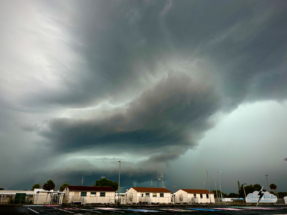
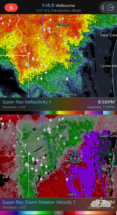
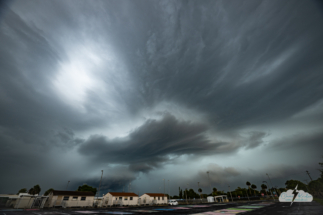
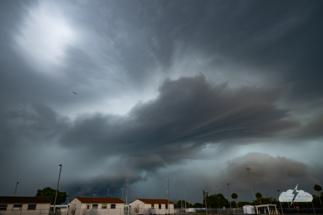
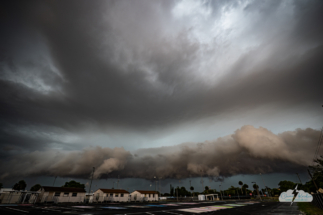
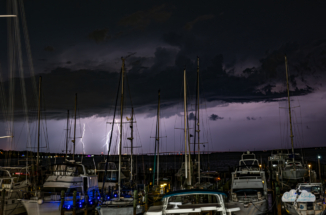
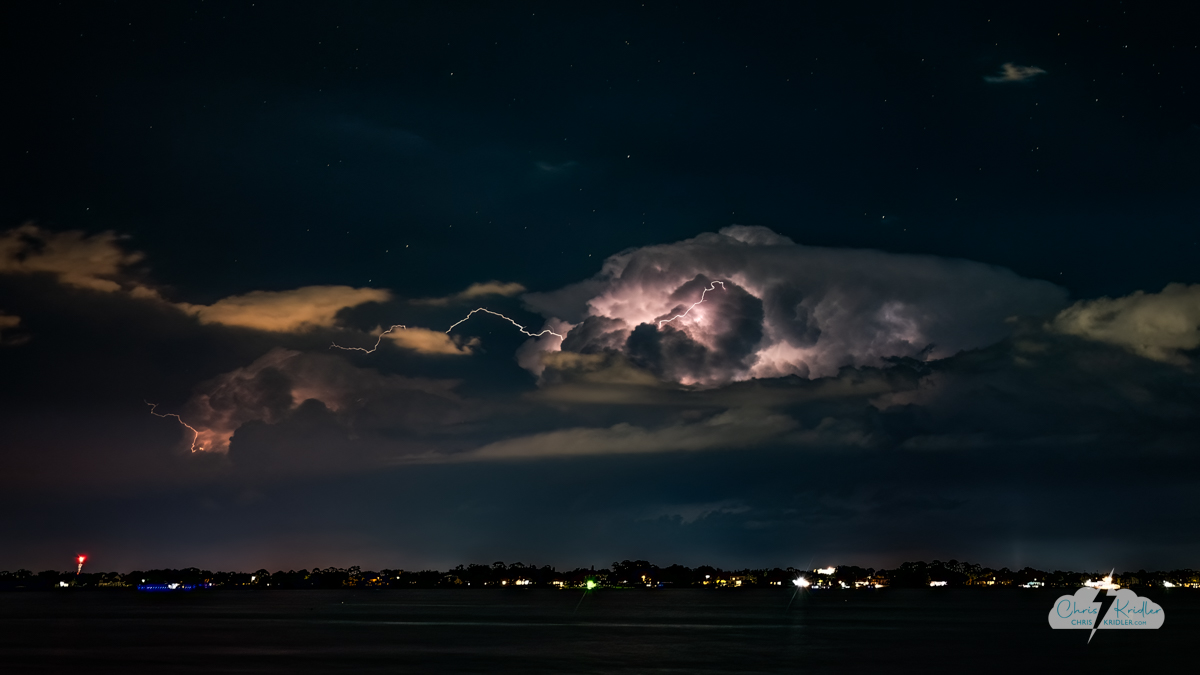
Lightning off Florida’s Space Coast on May 5, 2025, shot from Rockledge. Photo by Chris Kridler, ChrisKridler.com.
The thing about Florida storms is that they usually don’t last long, so I didn’t think it would be wise to drive all the way to the beach from the mainland to photograph it. I figured the cell would be dead by then. Instead, I found a spot in Rockledge on the bank of the Indian River Lagoon. There was some cloud clutter in the way, but the storm shot out some pretty nifty bolts regardless.
I was less than prepared. I had to crop the photos because I only brought one wide-angle zoom and the storm was a bit too far away. Obviously, I haven’t readied my gear for the Tornado Alley storm chasing trip yet, but that’s on the agenda this week. My storm-chasing partner Alethea Kontis and I will head out west soon. We’re looking for the next promising system. Stay tuned for more updates!
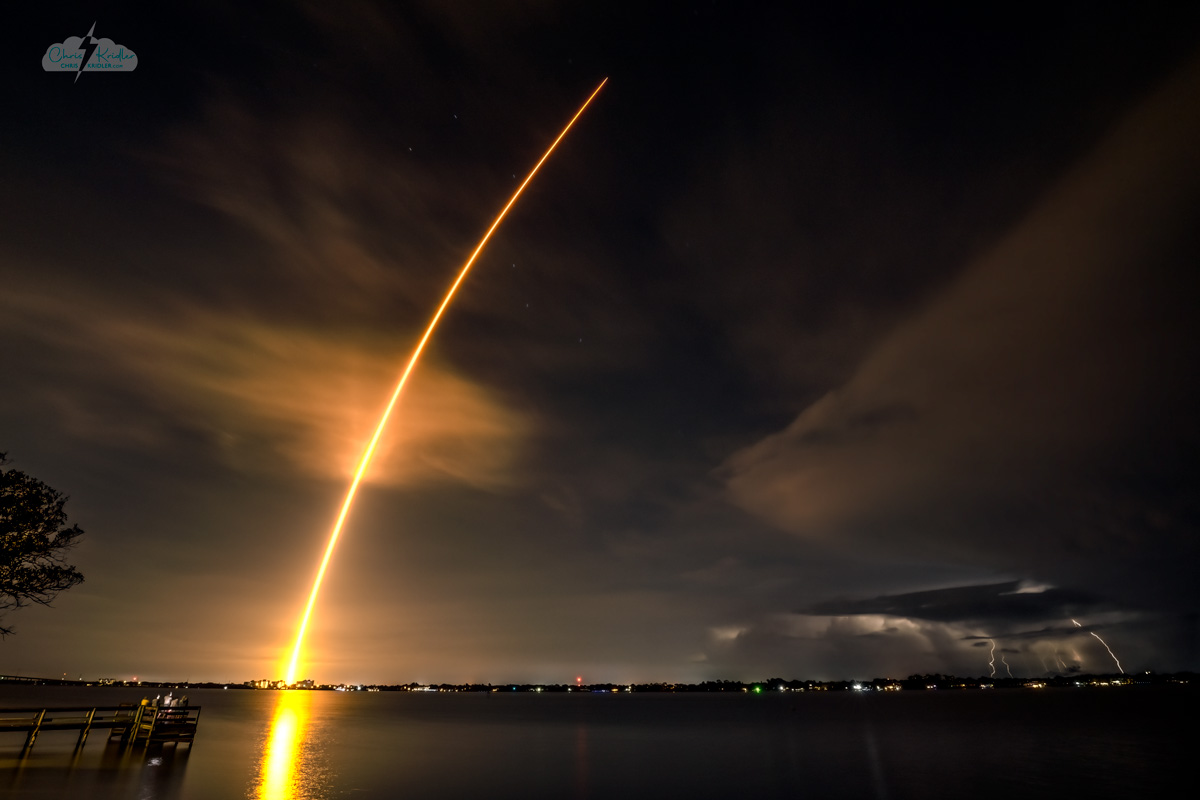
Falcon 9 rocket with the Fram2 polar orbit mission launches over a line of lightning storms on March 31, 2025, from Kennedy Space Center. Photo ©Chris Kridler, ChrisKridler.com
A line of lightning storms moved through the Space Coast tonight ahead of the launch of a Falcon 9 rocket with four civilian astronauts aboard. I was surprised the weather wasn’t an issue, but the rocket went high and south in a hurry. Still, I caught some lightning in the line in my time-exposure shot of the launch. The streak went right through the Big Dipper. Click on the photo to see a larger version in all its glorious detail.
I took this photo from the bank of the Indian River Lagoon in Rockledge, Florida, looking east. That’s the Rockledge city dock in the lower left, where people are holding up their phones to film the launch, and there’s lightning in the lower right. This was one exposure! I took several shots before the launch, thinking I might do a composite later, but no – the lightning cooperated, and I was able to enhance the image to make the bolts more visible.
Here’s one more shot at booster separation – a “jellyfish” effect in the upper right, with lightning in the lower left of the frame. Not as cool as the launch shot, but still pretty neat.
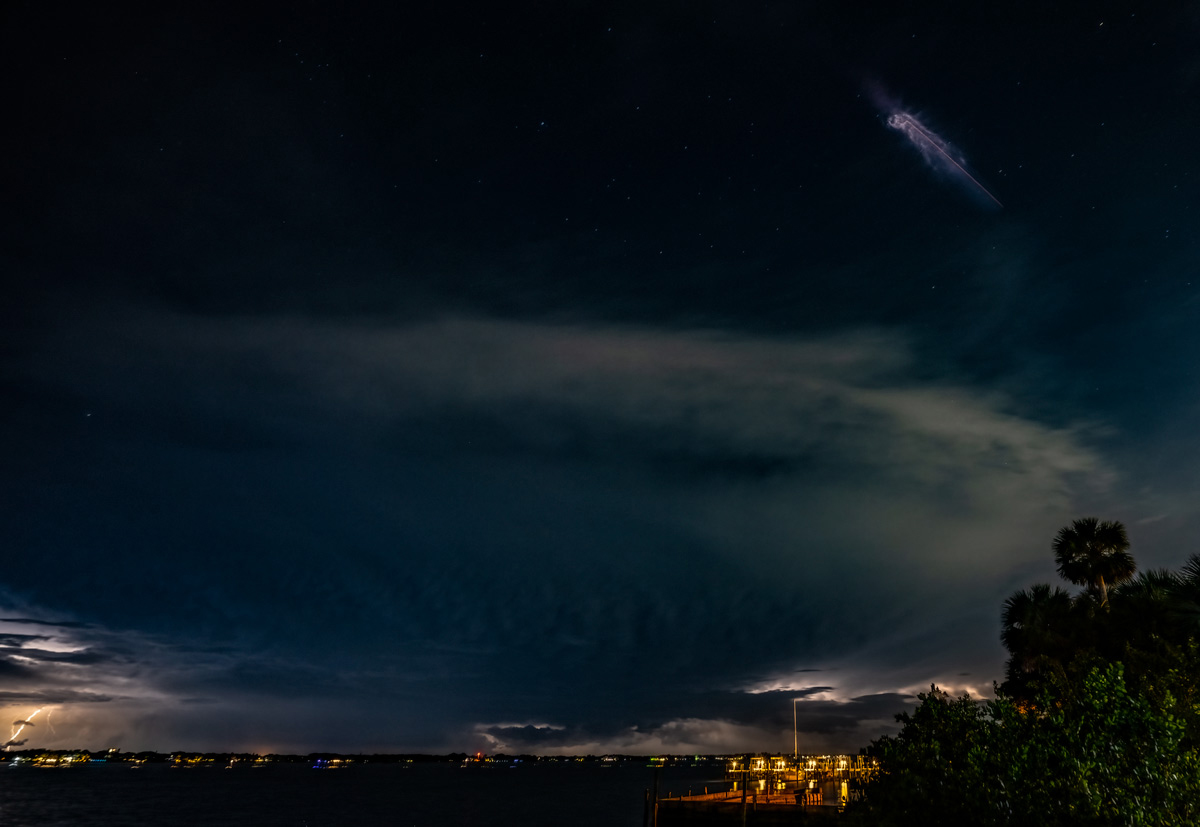
“Jellyfish” effect in the upper right from the Fram2 launch; lightning in the lower left. Photo shot in Rockledge, Florida, by Chris Kridler, ChrisKridler.com.
Girls Who Chase is a cool organization that aims to draw attention to women who chase storms and encourage girls to get into weather and the sciences. They also offer classes to folks who want to get into chasing. It was an honor to be featured with Alethea Kontis in their recent “Meet the Chasers” feature. We’re a rather eccentric duo in that, even though Alethea has science in her background and I have a great love of science and wrote about it as a journalist, we’re now writers of books (mostly) in real life. Check out the post to read the entire interview!
We also did a video to accompany the interview, which you can see right here. Thank you for the invitation, Girls Who Chase!
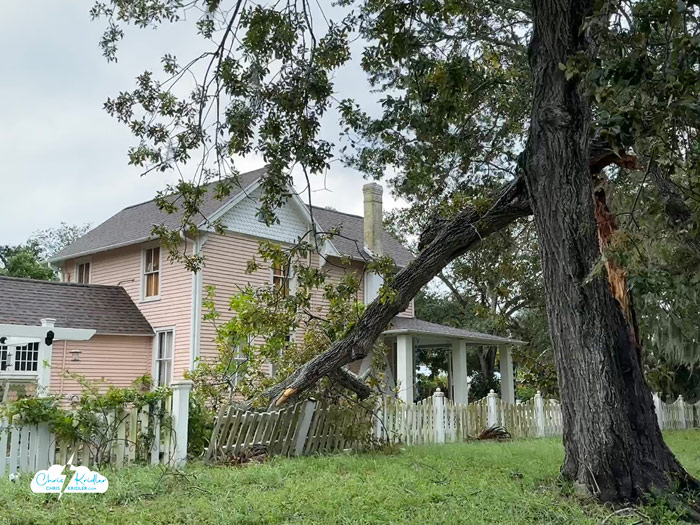
A tree split and took out a fence in Rockledge, Florida, thanks to Hurricane Milton.
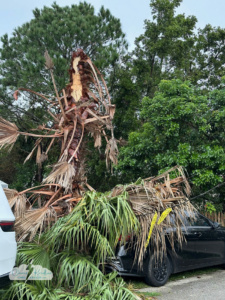
Hurricane Milton’s winds snapped this palm tree in half in Rockledge, Florida.
My heart goes out to everyone with damage, from the west coast, where big Category 3 winds and storm surge hit many Florida communities we love, to the east coast, menaced by monster tornadoes of the kind that are rare even in the Plains. One hit Cocoa Beach, not that far from us, and we had a few exciting moments in our semi-basement as I watched the radar. Part of me wishes I’d been chasing the tornadoes farther south, even though tropical tornadoes are difficult to chase given how dang fast they are, but I wanted to be home with hubby and the dogs. I hate to see the devastation and loss of life. It’s hard enough prepping for a hurricane, but even good hurricane prep doesn’t fully protect you against a violent tornado.
We had some minor tree damage at our house and a leak that isn’t going to be fun to find, though there was worse in our immediate neighborhood, as you can see from the photos here. And now I’m on a bit of a fact-checking rampage. Here’s a graphic I made showing the number of early tornado reports as recorded by the Storm Prediction Center for Hurricane Milton. There were 126 warnings issued on Oct. 9, according to reliable news outlets, and there were 47 initial tornado reports, contrary to even wilder numbers people are sharing on social media.
There’s confusion, I think, about what warnings mean. A warning doesn’t always translate to a tornado, as warnings are sometimes based on radar, and multiple warnings may be issued for the same tornado as it moves from one county to the next. A report doesn’t necessarily mean there was a tornado, but sometimes multiple reports can be made about the same tornado. Damage studies by the National Weather Service and photographic evidence help refine the numbers. We should be getting more accurate numbers soon, but as of today, Oct. 11, 2024, this is what we know. (Click on the graphic to see a larger version.)
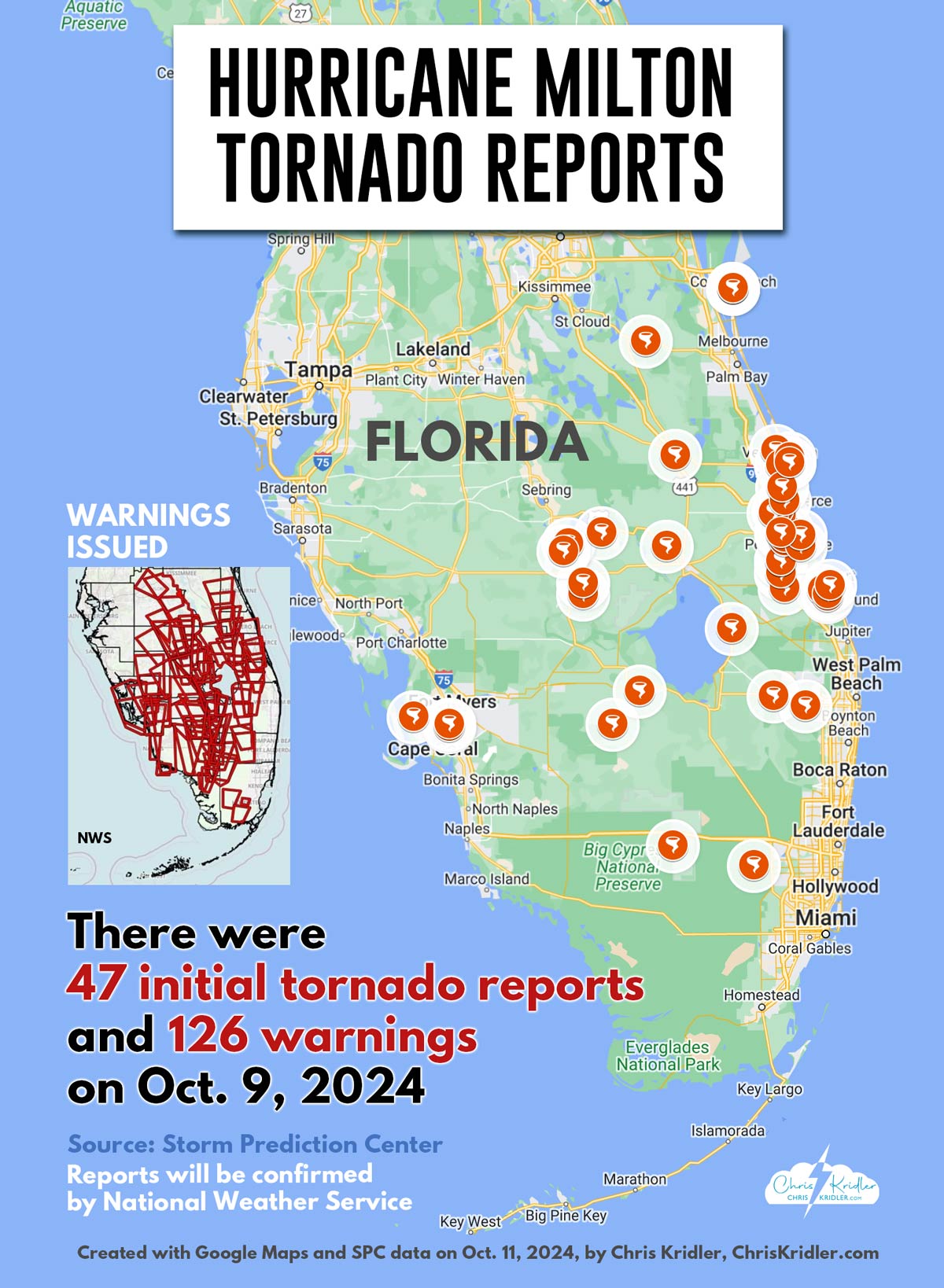
There’s a lot of crap floating around social media, including a nice photo of a shelf cloud taken in Cocoa, Florida, that’s being labeled as Milton coming ashore. I thought it might be my photo at first, but it’s by photographer Jennifer Cenker, who shot it on Oct. 1 from Merritt Island, looking west toward Cocoa. Someone stole it from her, labeled it as Milton, and it spread like wildfire. It’s very similar to one I took from almost the same location of a summer thunderstorm, with the Cocoa water tower visible at the end of the bridge. Please don’t share stuff unless you know where it comes from. This was my cranky Facebook post.
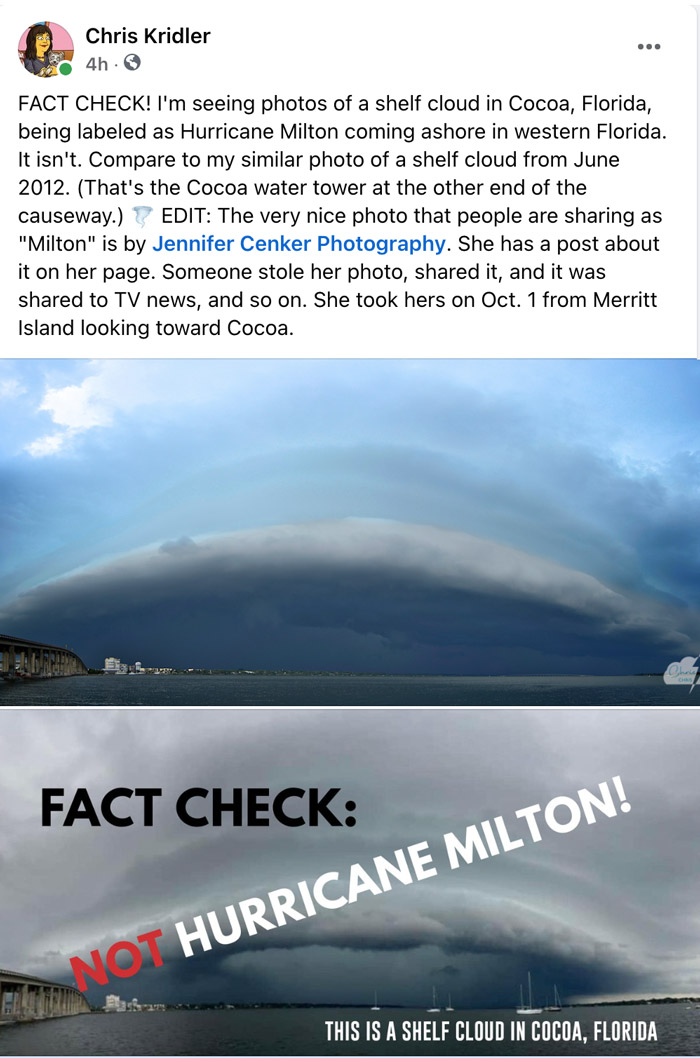
And lastly, a word about weather manipulation. Sure, humans have played with cloud seeding for a long time. It’s been tried in an attempt to increase rain or snow (which can work) or decrease hail (which probably doesn’t). And there have been other experiments in weather manipulation over the years. Did you know there was a phenomenon in Europe in the late 1800s that involved firing cannons at storms to prevent hail, on the theory that smoke might interfere with its formation? Hail cannons didn’t work, either, but the linked article shows how use of them snowballed — mostly thanks to people believing what they wanted to believe.
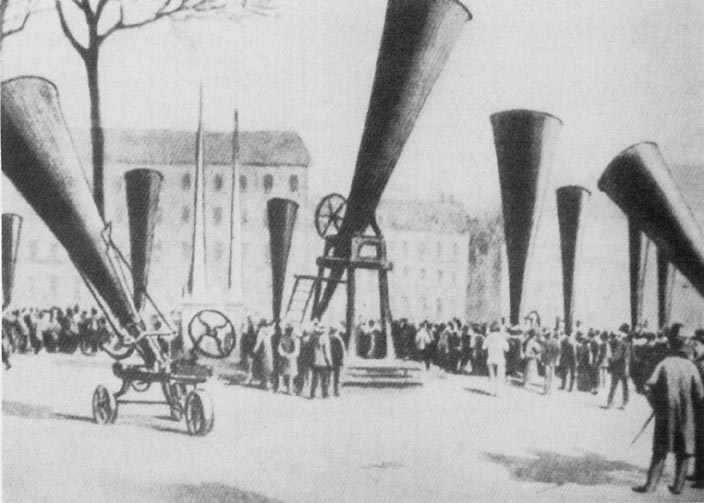
Sketch illustrating the International Congress on Hail Shooting in 1902. Public domain image courtesy of Wikimedia Commons.
Scientists make theories and experiment, and sometimes experiments prove them wrong. Then they come up with new theories. That’s how science works.
And despite other experimentation over the years, weather manipulation attempts on tornadoes or hurricanes do not work. Scientists can’t change the course of hurricanes, and politicians certainly can’t. Experiments in cloud-seeding hurricanes in the twentieth century did nothing. Hurricanes are monsters. Hurricane Katrina in a week released energy equivalent to 4 million Hiroshima atomic bombs. Humans have no technology that comes close to affecting the strength or path of these storms. So please take a deep breath before you share this stuff. If it sounds like a good story, it might be just that — a story. Maybe when you “do your own research,” you could consult actual scientists who have done actual research.
Thanks to the meteorologists who’ve been working tirelessly to make the forecasts and to get out warnings, from the National Hurricane Center and the National Weather Service to the TV meteorologists who’ve been working crazy hours and newspapers publishing essential information. And let’s not forget the NOAA and U.S. Air Force Reserve Hurricane Hunters, whose continual flights into Milton brought real-time reports and data that were fed into the computer models. I can’t imagine how exhausting this past week has been. That said, let me know the next time you have an empty seat on the P-3, OK?
Keep your eyes to the skies, folks. The season isn’t over.
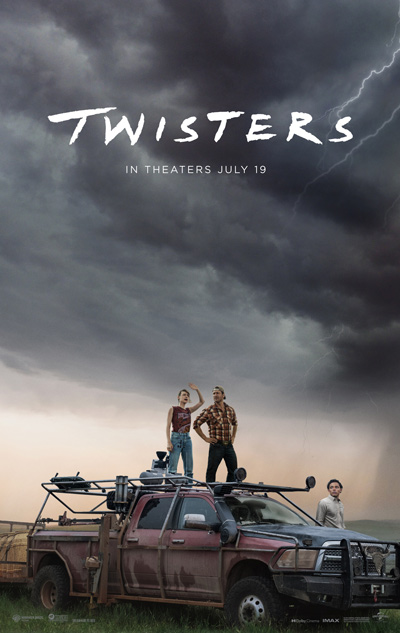
TWISTERS brings storm chasing back to the big screen.
The release of Twisters this summer has me thinking a lot about fictional accounts of storm chasing—and my own writing.
I’m a storm chaser, and I took the movie for what it was: big-budget entertainment. The film’s science stretches credulity, and the actions of the storm chasers seem unlikely at best, but it’s always fun to watch Hollywood’s take on your life’s passion. The tornadoes looked better than they did in Twister, and I appreciated the inside references to our hobby and the original movie. Yet I think I’ll always have a special place in my heart for the geeks of Twister.
When I wrote my novels about storm chasers, the books’ quirky, obsessed characters were at least as important to me as the action. I’ve felt a need to revisit the books given all of the chaser stuff appearing in media lately.
Everything I write means something to me, but these “books of my heart” still give me a thrill. They remind me there’s value, perhaps the ultimate value, in writing about something you love.
I saw Twister before I ever went chasing, though I’d seen scientific storm chasers in documentaries and had a lifetime fascination with tornadoes. So Twister didn’t push me into storm chasing, but it reinforced my curiosity.
A random Internet search got me into Plains chasing for the first time when I discovered Cloud 9 Tours back in 1997. That experience sparked a lifelong love of storm chasing, led to hundreds of thousands of miles on the road, and fueled my photography and imagination, including my writing.
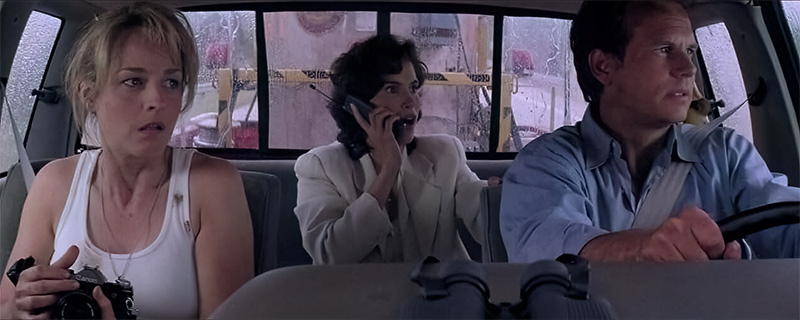
“We got cows!” Who can forget this scene from TWISTER with Helen Hunt, Jami Gertz and Bill Paxton?
Chasing is seasonal, so it was never my job. For years, I worked in newspapers and occasionally toiled in fiction on the side. Like most writers, I suffered rejections that discouraged me for way too long. But my immersion into chasing culture compelled me to write a novel—which became more novels—about storm chasers.
That first novel was influenced by a lot of factors: my passion for chasing, obviously. What I learned in creative writing classes in college, which had a strong literary bias. And a compulsion to get inside these characters’ heads.
First novels sometimes come with baggage as writers find their way. Funnel Vision wasn’t my first novel (my unpublished novels likely will remain so), but it became the first I published and then the first in a series. If I wrote it today, it would probably be very different. I’ve since learned that if you think you might write a series, start as you mean to continue. Conceptualize. Plan. Write more than one book before you publish. Plot a few books out, even if you don’t nail all the details.
Funnel Vision has several storm-chasing action sequences, including a page-turning chase that takes up most of the last third of the novel. But there’s also lyrical scene-setting and serious stuff, including a shock and a lot of emotion—it is, shall we say, a little more literary than books two and three. As in the other books, there are romantic elements, with a couple of steamy scenes, though it’s not a romance, either.
Judy, the heroine of the first novel, is a photographer who chases for art and therapy after surviving a tornado that hit her town when she was a child. The main male character, tornado researcher Jack, is obsessive and impulsive, and it takes him three books to figure out his life. They’re part of an ensemble cast.
Funnel Vision is wildly cross-genre. And cross-genre books are really hard to market.
Ignoring conventional genres was just one of the “mistakes” I made when I decided to self-publish, but I was a newbie at indie publishing. I didn’t know that books that fit neatly into a category sold better. Or that those books should have clearly defined genre covers that looked a lot like other books in their category. (I changed the covers later.)
And I didn’t realize that action-adventure wasn’t a very popular category to begin with. These days, there are a lot of erotic romance books with weird AI covers polluting the category on Amazon. (I have no problem with erotic books with AI covers, but they shouldn’t be in action-adventure. I know. I digress.)
Truthfully? I didn’t care about writing to market, even though I tried to find the right niche for the books. I have a passion for these stories, and I wanted to write them regardless of their marketability.
After a bunch of agent rejections for Funnel Vision, a fallow period after my mother’s death, and the rise of indie publishing, I revised it one more time and launched it into the world in 2012. Indie publishing experts fondly refer to this era as The Gold Rush. It wasn’t golden for me, as I published one book a year for three years and didn’t sell all that many. But it was satisfying to have the books out there—and a bit terrifying as well.
The books became a series, and they evolved. Sometimes I think Funnel Vision is almost a prequel, for the reasons cited earlier, though any of the books can be read on their own. Tornado Pinball and Zap Bang continue the stories of Jack and some of the other characters, and they are assuredly adventure novels, though they still have characters with issues and a few steamy scenes and an often humorous, satirical bent.
They also have driving plots that would totally work as a movie. In Tornado Pinball, my hero acts as a consultant to a TV crew trying to launch a human tornado probe as a rival chaser complicates their quest. In Zap Bang, he and a badass pilot—a woman and war veteran—are drawn into a dangerous lightning study even as they’re drawn to each other.
And since I’ve been thinking about fiction starring storm chasers and my own books, I just did something I’ve been longing to do for a while—another read of these novels, with a light edit. I was relieved to find that I still love them.
Why a light edit, and what does that mean?
A little history: I started my newspaper career as a copy editor. (Or as some style guides would have it now, copyeditor.) I transitioned into reporting. And when I wrote the books, I was still working in AP Style. I learned best practices for fiction that served me well when I left newspapers and eventually began editing books as my day job.
Now I use Chicago Manual of Style (with a few quirks—that’s a privilege of indie publishing) and Merriam-Webster’s online dictionary as my standards. So the light edit ensured the books meet current standards. I polished a sentence here and there, but I refrained from a rewrite. And I tweaked a few of the outdated tech and other references that might’ve pulled readers out of the story, without changing the plot or timeline.
As I say in the notes at the back of Funnel Vision, it will always be a product of its time. But a few subtle changes make it more timeless. At least for the next few years! If you download the Storm Seekers Series ebooks or order the paperbacks, you’ll get the most up-to-date versions.
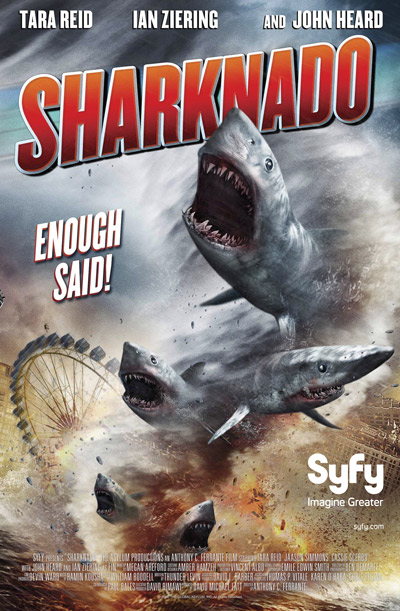
The silly SHARKNADO franchise took tornado movies to the ultimate extreme.
There’s been a lot of tornado-rich fiction on big and small screens—and some in books—in the years since Twister, from the cheesy awesomeness of the Sharknado franchise and other bad TV movies to more earnest attempts like Supercell. (Which has a character named Zane, as do I. Huh.)
It’s hard for storytellers to resist the eternal conflict of human vs. nature, ramped up to F5 levels (or EF5, for the weather geeks). The sometimes ludicrous scripts of disaster movies probably shape what readers expect of books with storms in them. But I appreciate stories that get at least some of it right.
I think readers who loved Twisters might enjoy novels written by an actual storm chaser. Of course they’re fiction. The characters are fictional. The research projects and TV stunts are fictional. But the stories are authentic.
I’ve been thinking a lot about authenticity, which has become kind of a buzzword in marketing that often translates to “go on social media and show the real you.” Which is hard if you’re a private person. I think authenticity means a lot of things—not just an authentic presence but, in writing, authentic details and emotions and, especially, an authentic voice.
I am my writing. But my writing is several different things, and I like writing in multiple genres.
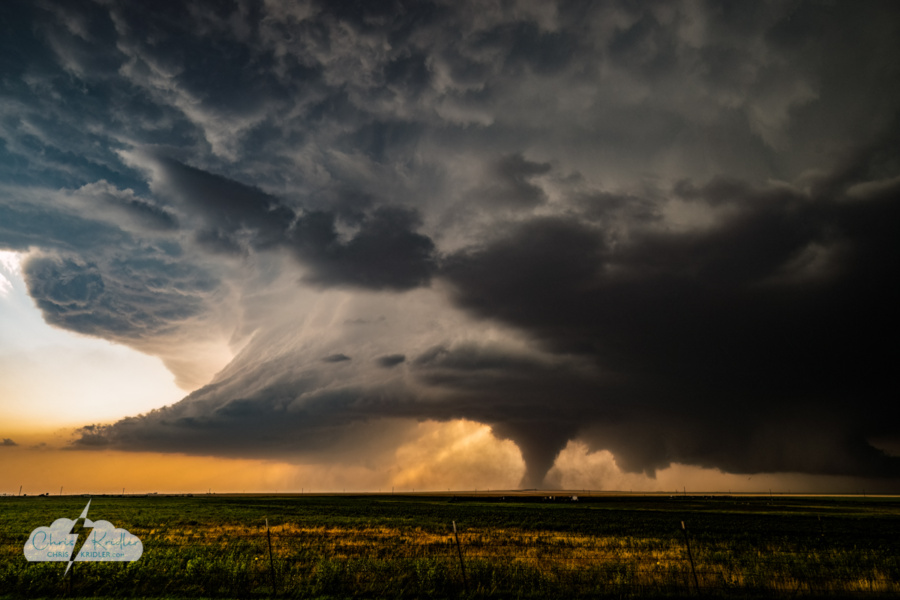
It doesn’t get more authentic than this: a tornado I chased on May 23 in Oklahoma with friends.
In a New York Times interview, mega-bestseller Colleen Hoover, who writes in several genres and has a massive TikTok following, said, “I kept being told that authors need to brand themselves as one thing. And I was like, well, why can’t I brand myself as everything? Why can’t I just brand myself as Colleen Hoover?”
I don’t expect to get anywhere near her sales level, but I like the way she thinks.
I’ve been writing mysteries under a pen name, Lucy Lakestone, which I kept on the down-low for a while, partly because Lucy’s first series was steamy romance. I wasn’t sure people who knew Chris Kridler the Journalist/Storm Chaser were ready for that. Eventually I realized that hardly anyone cares.
Then I (well, Lucy) started the Bohemia Bartenders Mysteries, which are funny mysteries I call quasi-cozy. What does that mean? Cozy mysteries are usually set in a closed environment like a small town; my bartenders travel. Cozies tend to be tame, curse-free, with violence off the page and no sex. My mysteries teeter right on the edge of the category. They have occasional cursing, they hint at heat but don’t show anything explicit on the page, and there’s always action and danger. So calling them “quasi-cozy” in every book description is my way of saying, hey, these defy genre expectations, and you’ve been warned.
You’d think I would’ve learned my lesson with the storm chasing books when it comes to writing to market and fitting into a genre. But life is short, and while I want to make a living, I also want to write books that mean a lot to me, pigeonholes be damned. I know some people do both. I’m working on it. But with my time getting shorter, I’m committed to writing authentic stories I care about.
Writing is hard. And publishing can be brutal. I have friends who are killing it. Others are struggling to break even, break out. The quality of a book doesn’t necessarily determine its success in a flooded market.
I have a long way to go before I declare myself a success. The big question is, what is success to you? And is the struggle worth it? If I’m going to work this hard at the dream, I want to love what I write.
If you care about what you write, your passion will show through, as long as your skills match your enthusiasm. While it helps to write something you love that also fits into a marketable category, I hope your joy comes first.
“If you’re just chasing the algorithm,” Mal Cooper of The Writing Wives said in a recent video, “… you’re losing your authenticity and you’re just shifting toward the mean. You’re making the most average thing that you can. That’s what the algorithm is looking for, right? It’s looking for the most average thing that’s going to appeal to the largest group of people, and you’re going to sacrifice your authenticity when you do that. So that thing that actually makes you unique and interesting and have a draw is the very thing you get rid of when you chase the algorithm. So that’s why I’m not a fan of doing that. I’m a fan of being out there and honest and real about yourself and your stories and your marketing.”
I love this philosophy. My books aren’t for everybody. Heck, no one’s book is for everybody, and if you’re selling yours like it is, you’re missing the point. I’m looking for the readers who get it.
If I write any more Storm Seekers books, they’ll be authentic, as they always have been. And for me, the storm chaser who can’t get enough stories about twisters, the experience will be a whole lot of fun.
Thanks to The Writing Wives for permission to quote from the video on achieving success; they also offer a free workbook if you want to check it out.
Learn more about Chris Kridler’s Storm Seekers Series.
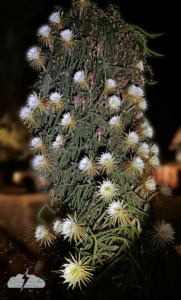
Our neighbors kept a dead palm’s trunk because it hosts these beautiful cactus flowers.
June 1 was a big night for the blossoms, so I set up a time-lapse with my GoPro to capture the blooming of three of these flowers. For the past couple of years, I’ve coaxed these vines to take hold on our oak tree after seeing an incredible picture of a tree in Orlando just dripping with the flowers. That’s a while off for our tree, but even a few of these blooms are gorgeous.
In the video, in addition to the time-lapse video, I show you some of the flowers growing on a palm tree in our yard, as well as a palm trunk in the neighborhood that is simply covered with blooms. Enjoy the magic!
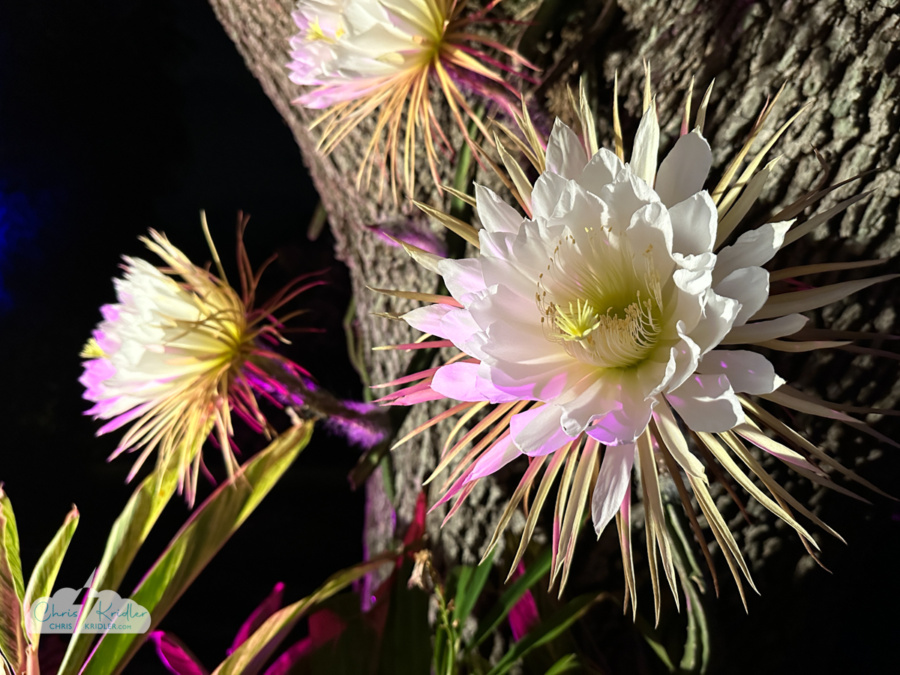
Night-blooming cereus. The pink comes from extra lighting I added for this year’s video.
We started May 23 with casual optimism about our chase prospects. The fun part was that Alethea Kontis and I were storm chasing with Jason Persoff and Dave Lewison (Bill Hark had ended up elsewhere the previous day, but he would get great close-up views of what was to come). And we were chasing dryline storms, which I enjoy. I can’t say our expectations were high; the Storm Prediction Center had outlooked a 5 percent tornado risk over a long vertical swath along the dryline and north, encompassing much of western Oklahoma, central Kansas and eastern Nebraska, but we had no idea what a spectacular day would unfold.
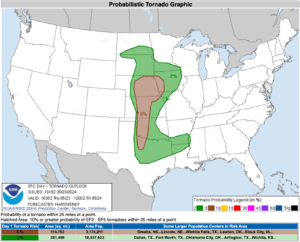
The Storm Prediction Center issued a slight risk of severe storms that included southwestern Oklahoma with a 5 percent tornado risk.
We aimed for northwest Oklahoma first and got partway there, ran into chaser friends and waited for a bit. I had increasing levels of anxiety as I watched the storms that formed farther south showing supercellular characteristics on radar. Fortunately, Jason and Dave were thinking the same thing, so we made the decision to head that way. Sometimes you stick to your initial target for good reasons, but as the day wears on – we’d passed 5 p.m. – you chase what presents itself. Thank goodness we did.
We stopped west of Duke to survey an approaching supercell near Hollis, peering through humid, dusty, hazy air. The photos show how weird and dreamlike it appeared. It hadn’t yet started to spin like mad. It took a collision of cells to do that.
Our two vehicles repositioned south to different locations as our target storm approached. Alethea and I found a spot atop a hill on an atmospheric red-earth road off Route 34 that offered an amazing view as the storm tightened up and its structure evolved into a layered spinning top. It almost tornadoed, producing a scuddy lowering. But as the cell eased closer and we started to get pinged by hail, we made the decision to back off a bit down to Route 6, which, as any chaser knows who was there that day, was closed eastbound for construction. Argh!
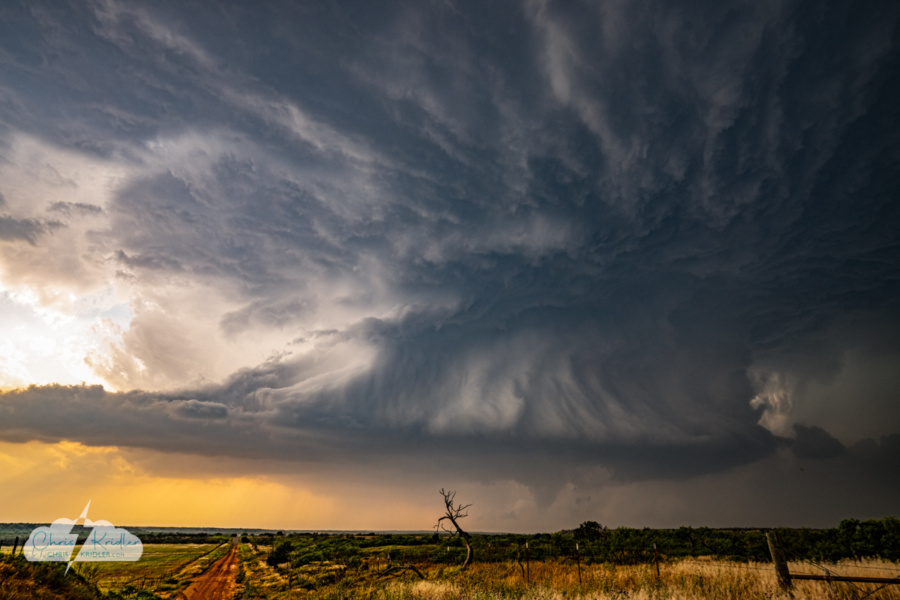
We thought the storm might be on the verge of a tornado at 6:42 p.m.
In hindsight, we probably would have had a great close-up view where we were (extremely close!), or at least on Route 6, but after meeting up with Jason and Dave again just south of Route 6, we made the choice to get more directly east of the meso and get a clearer view of the potential tornado with the magnificent structure. The worst part of that decision was the risk – not of danger but of the possibility of missing everything.
As the storm sucked in air from the south, blowing dust obscured the base so much that flying brown dirt was about all you could see until we got farther east. So while eyeing the radar and seeing tornado/funnel reports on SpotterNet, I yelled “We’re missing it!” as I drove behind Jason and Dave in our quest to get east and then north. Alethea had to put up with my crankiness.We missed perhaps 15 to 18 minutes of the tornado in progress, though I did get a snapshot out the window of the storm with a young tornado under it as we zoomed east. But what we saw from Olustee would be incredible as it continued for another half hour.
As we repositioned, we danced with lots of other chasers and research crews and mobile radars as they scrambled all over the grid of roads — mostly gravel, with rare paved options that Dave figured out — trying to find their viewpoint of choice. NSSL’s Low-Level Internal Flows in Tornadoes experiment (LIFT) got data around the storm with mobile radar and Doppler lidar. A Texas Tech mobile Doppler got data from within a mile of the tornado. And other research groups were on this tornado, too — the National Severe Storms Laboratory reported there were at least five mobile radars on the job, plus drones.
Yet as we buzzed into Olustee and beelined for the western edge of town, where we could clearly see a multivortex tornado in progress to the west, our group was alone for the moment. Well, alone with the townsfolk and a clear view over the Plains. It’s a rarity to view any storm these days in a quiet place without lots of storm chasers around you.
I pulled beyond and to the left of Jason and Dave, figuring I’d be out of the way, out of their direct line of sight, and they could always come forward a few steps. They both had the brilliant idea of photographing the storm with my car in the foreground, and the results were very cool – the CR-V appears tiny against the backdrop of the magnificent supercell.
The supercell looked like something out of a dream, thanks to dust and distance (5 miles?), and I made a choice in editing the photos to “dehaze” and bump up the clarity and contrast to bring out its features. It cycled from one tornadic shape to another – multivortex, cone, stovepipe, wedge – appearing to dissipate and reappearing again.
At one point, a second, smaller tornado was on the ground to the northwest of the main one. This satellite tornado damaged a home, the National Weather Service later found. Its preliminary rating was EF0.
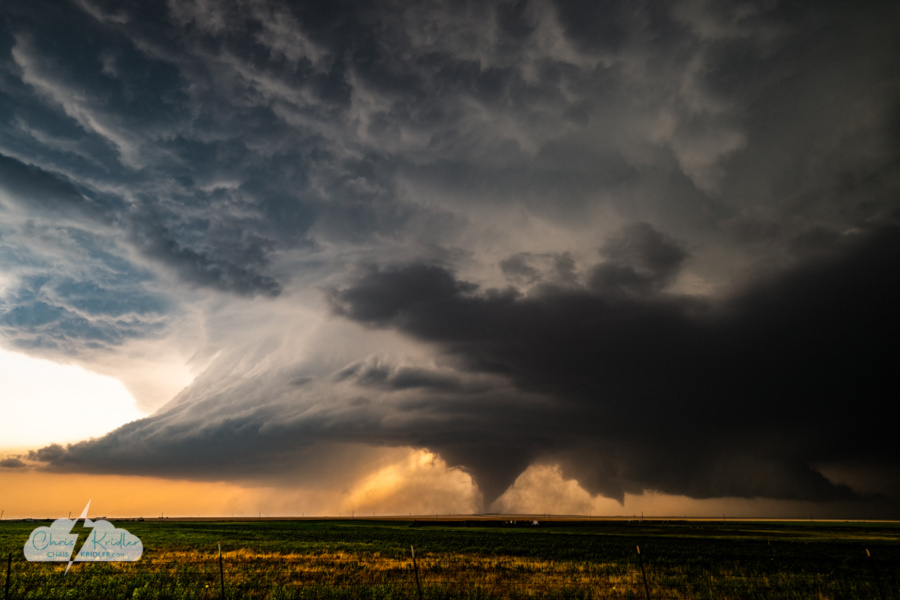
A second tornado appeared behind the first. The satellite tornado damaged a house.
The National Weather Service issued continuous warnings of the tornado, first radar-indicated, then confirmed: “At 705 PM CDT, a confirmed large and extremely dangerous tornado was located 6 miles north of Eldorado, moving east at 5 mph.” The tornado damaged several barns and at least half a dozen houses in Jackson County, but at least it wandered in a sparsely populated area, and I’ve found no reports of injuries.
While the damage was rated EF2, which the National Weather Service attributed to power poles being “snapped,” actual wind speeds recorded by mobile radars suggest the tornado’s winds could have been in the 180 mph range, or EF4, NSSL reported — IF wind speeds were used in ratings. Which they aren’t. Ratings on the Enhanced Fujita Scale are based on damage.
And this tornado was on the ground for 53 minutes, according to the National Weather Service summary, tracking across 15 miles, from 8 miles southwest of Duke, crossing north of Eldorado, and ending about 5 miles east-southeast of Duke. It grew to more than a mile wide at one point and was beautifully visible from our position on the west edge of Olustee, which was eventually included in the warning area. In fact, a local law enforcement officer came up to us shortly after we arrived, had a chat with Jason about what we were seeing, and headed off to sound the siren, which blared eerily as we filmed the tornado. I was concerned about the town lying in the path. Fortunately, the tornado headed in a northeasterly direction that took it away from the town.
As an aside, tornadoes usually become known by the town they’re closest to — or whatever catches on as folks report it later. I’ve heard this described as the Eldorado tornado, the Duke tornado, and the Olustee tornado, as it occurred between these three towns. While any of these are valid, I’ve been calling it the Eldorado tornado. I guess we’ll see what the scientists call it.
I was so stunned by the beauty of this tornado and supercell in stills that I focused almost entirely on still shots with my Nikon Z28. I should’ve at least pulled out a GoPro and stuck it on a tripod, or taken the extra minute to put out a DSLR in video mode. Instead I took very little video with the Z28, since I was using it to shoot stills, and shot video clips with my phone — sometimes shooting both at the same time. So the video could be steadier. I carry multiple tripods but didn’t get one out. Maybe I worried I’d miss something in the process. When it was all over, I was a little surprised to see how much video I’d shot.
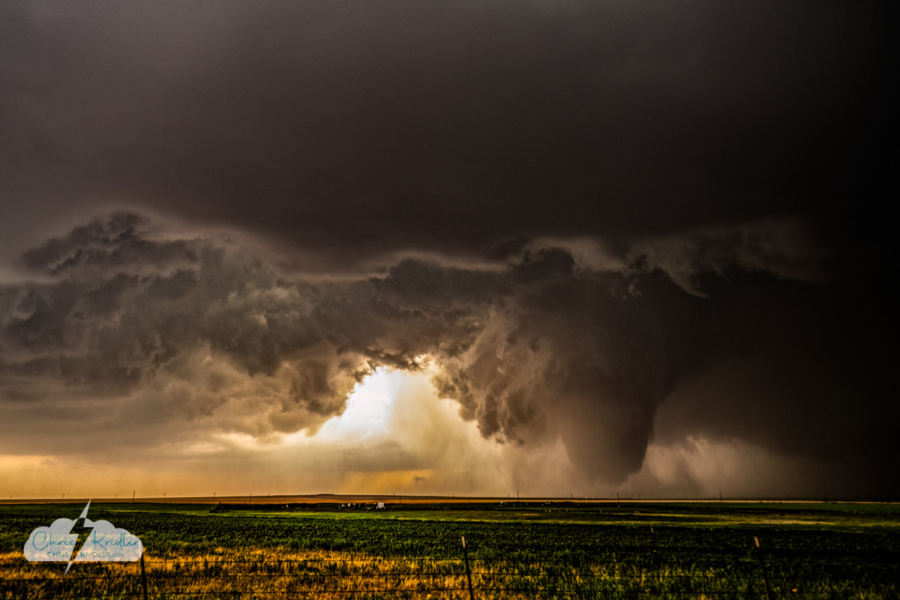
At 7:33, the fat tornado looked more like a wedge. At one point it was more than a mile wide, according to the National Weather Service.
It’s not unusual for chasers to have regrets about chases. Things happen fast, adrenaline is flowing, and you make a lot of decisions in the moment. Dave and Jason wish they’d sent up their drones. My regret was that I didn’t pay more attention to video. Alethea shot the whole thing on video, and her footage is awesome. At least my GoPro was on the dash, and in spite of raindrops and the occasional windshield wiper and chaser cameo, or maybe because of those things, which give the video a naturalistic vibe, the footage is kinda cool. I’m including the timelapse in my video report.
One thing I’m glad about, despite my scatterbrained videography, is that I looked at the tornado with my eyes and not just the lens. “Just take your eye away from the camera for a second,” Dave told Jason, though it was a good reminder for all of us. “Remember.”
The storm seemed to exercise all its drama at once, and while we followed it for a while, it didn’t cycle up again into tornado mode. There was some really hot lightning that died down just after we found a place to shoot it. And then the chase was over.
I’m keen to see what’s learned from this storm, given all the research data and documentation by so many storm chasers. The tornado was probably in my top five, though I haven’t thought much yet about where I’d rank it. Just like I don’t actually count how many tornadoes I’ve seen. The ones that matter are the pretty ones I capture in a photo. And in this case, hundreds and hundreds of photos. It was truly an extraordinary storm chase.
The video is above, and in spite of my worries at the time, there’s quite a bit of tornado footage in it! To start a slide show with captions, click on any photo below.
